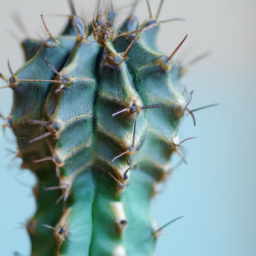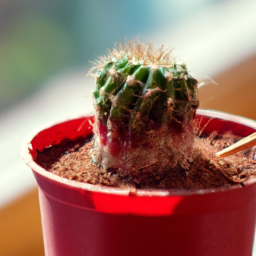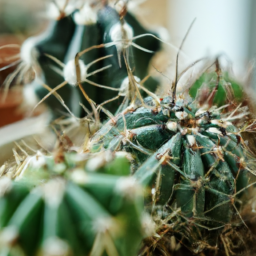
Are you considering adding some cactus plants to your indoor space? If so, it’s important to understand the essentials of cactus plants care indoor to ensure they thrive in their new environment. Cacti are known for their unique appearance and low-maintenance nature, making them a popular choice for indoor plant enthusiasts. In this blog post, we’ll cover everything you need to know about caring for cactus plants indoors, from proper watering techniques to the best lighting conditions. Whether you’re a seasoned plant parent or a beginner looking to add some greenery to your home, this guide will help you keep your cactus plants healthy and happy.
Cactus Plants Care Indoor: A Comprehensive Guide
Choosing the Right Cactus Plants for Indoor Care
When it comes to caring for cactus plants indoors, the first step is choosing the right species that will thrive in your home environment. Not all cacti are suited for indoor conditions, so it’s important to select varieties that can adapt to lower light levels and dry air.
Consider the Light Levels in Your Home
Before selecting a cactus plant for indoor care, take note of the light levels in your home. Most cacti require bright, indirect sunlight to thrive. If you have a window that receives plenty of sunlight throughout the day, you can choose cacti that are more light-demanding. However, if your home has limited natural light, opt for low-light cactus varieties that can still grow and flourish in such conditions.
Some popular cactus species that do well in low-light environments include the Zebra Plant (Haworthia fasciata) and the Christmas Cactus (Schlumbergera bridgesii). These cacti can tolerate shade and are perfect for indoor settings with less sunlight.
Alternatively, if you have a sunny window sill or a well-lit room, you can consider cactus species like the Bunny Ear Cactus (Opuntia microdasys) or the Golden Barrel Cactus (Echinocactus grusonii), which thrive in bright light conditions.
Understand the Humidity Levels in Your Home
Cactus plants are adapted to arid environments and prefer low humidity levels. When choosing cacti for indoor care, consider the humidity levels in your home. If you live in a dry climate or have central heating that dries out the air, most cactus species will do well in such conditions.
However, if you live in a humid environment or have a bathroom with high moisture levels, opt for cacti that can tolerate higher humidity. Some cactus varieties, like the Rhipsalis or the Orchid Cactus (Epiphyllum), thrive in more humid conditions and can be a great choice for indoor settings with higher moisture levels.
Remember to avoid placing cacti near drafty windows or vents, as sudden temperature changes and drafts can stress the plants and lead to health issues.
Selecting the Right Size and Shape of Cactus Plants
When choosing cactus plants for indoor care, consider the size and shape of the plants. Some cacti species can grow quite large over time, while others remain small and compact. If you have limited space in your home, opt for smaller cactus varieties that won’t outgrow their containers quickly.
Additionally, consider the shape of the cactus plants. Some cacti have long, spiky stems, while others have a more rounded or globular form. Choose cactus species that appeal to your aesthetic preferences and fit well with your home decor.
Popular choices for indoor cactus plants include the Moon Cactus (Gymnocalycium mihanovichii) with its colorful, grafted stems, and the Old Lady Cactus (Mammillaria hahniana) with its distinctive white hairs and pink flowers.
By considering the light levels, humidity levels, and size and shape of cactus plants, you can choose the right species that will thrive in your indoor environment and bring a touch of desert beauty into your home.

Essential Tips for Caring for Cactus Plants Indoors
Choosing the Right Cactus
When it comes to caring for cactus plants indoors, the first step is to choose the right type of cactus for your home. There are many different varieties of cactus plants, each with their own unique care requirements. Some cacti thrive in bright, direct sunlight, while others prefer indirect light. It’s important to do your research and select a cactus that will thrive in the conditions of your home.
Once you’ve chosen the right cactus, it’s important to provide it with the proper growing conditions. Cacti prefer well-draining soil, so be sure to plant your cactus in a pot with plenty of drainage holes. You can use a cactus-specific potting mix, or create your own by mixing equal parts potting soil, sand, and perlite.
Watering and Feeding Your Cactus
One of the most important aspects of caring for cactus plants indoors is proper watering. Cacti are desert plants and are adapted to survive in dry conditions. Overwatering is one of the most common causes of cactus plant death, so it’s important to water your cactus sparingly. In general, you should water your cactus only when the top inch of soil is dry to the touch. During the winter months, you can reduce watering even further, as cacti go dormant during this time.
In addition to proper watering, it’s important to feed your cactus regularly. During the growing season, from spring to fall, you can feed your cactus with a cactus-specific fertilizer once a month. Be sure to follow the instructions on the fertilizer package, as over-fertilizing can harm your cactus.
Providing the Right Environment for Your Cactus
In addition to proper watering and feeding, it’s important to provide your cactus with the right environment to thrive. Cacti prefer bright, indirect sunlight, so be sure to place your cactus in a sunny window where it will receive plenty of light. If you notice that your cactus is stretching or leaning towards the light, it may not be getting enough sun.
Cacti also prefer warm temperatures, so be sure to keep your cactus in a room where the temperature remains between 60-80 degrees Fahrenheit. Avoid placing your cactus near drafty windows or air vents, as sudden temperature changes can stress the plant.
By following these essential tips for caring for cactus plants indoors, you can ensure that your cactus thrives and remains healthy for years to come. Remember to choose the right cactus for your home, provide proper watering and feeding, and create the right environment for your plant to flourish. With a little care and attention, your cactus will reward you with its unique beauty and resilience.

Common Mistakes to Avoid When Caring for Indoor Cactus Plants
As an expert in caring for indoor cactus plants, I have seen many common mistakes that can harm these unique and beautiful plants. In this guide, I will highlight three of the most common mistakes to avoid when caring for indoor cactus plants.
Overwatering
One of the most common mistakes that people make when caring for indoor cactus plants is overwatering. Cacti are desert plants and are adapted to survive in dry conditions with infrequent rainfall. When cacti are overwatered, their roots can rot, leading to root rot and eventually death of the plant.
To avoid overwatering your indoor cactus plants, make sure to let the soil dry out completely between waterings. Only water your cactus when the top inch of soil is dry to the touch. It’s better to underwater than to overwater your cactus plants.
Another way to prevent overwatering is to use a well-draining soil mix specifically designed for cacti and succulents. This will help excess water to drain away quickly, preventing root rot.
Insufficient Light
Cacti are sun-loving plants that require bright, indirect light to thrive. One common mistake that people make is not providing enough light for their indoor cactus plants. Without enough light, cacti can become etiolated, meaning they will stretch out and become weak and leggy.
To ensure that your indoor cactus plants get enough light, place them near a south or west-facing window where they can receive bright, indirect sunlight for at least 6-8 hours a day. If natural light is limited, you can supplement with a grow light to provide the necessary light for your cacti.
Regularly rotate your cactus plants to ensure that all sides receive equal light exposure and prevent them from leaning towards the light source.
Improper Potting and Repotting
Another common mistake when caring for indoor cactus plants is improper potting and repotting. Cacti prefer to be slightly root-bound, so it’s important to choose a pot that is only slightly larger than the plant’s root ball. Using a pot that is too large can lead to overwatering and root rot.
When repotting your indoor cactus plants, make sure to use a well-draining soil mix and handle the plant carefully to avoid damaging the delicate roots. Repotting is best done in the spring or early summer when the plant is actively growing.
It’s also important to avoid repotting your cactus too frequently, as this can cause stress to the plant. Only repot your cactus when it has outgrown its current pot or if you notice signs of root rot.
I’ll leave you with these final thoughts
Cactus plants are a popular choice for indoor houseplants due to their unique appearance and low maintenance requirements. To ensure that your cactus thrives indoors, it’s important to provide the right care and environment. One key aspect of caring for cactus plants indoors is to provide them with plenty of sunlight. Place your cactus in a sunny spot near a window where it can receive at least six hours of sunlight each day. If natural sunlight is limited, you can supplement with a grow light to ensure your cactus gets the light it needs to thrive.
Another important aspect of caring for cactus plants indoors is to water them properly. Cacti are desert plants and are adapted to survive in dry conditions, so it’s important not to overwater them. Allow the soil to dry out completely between waterings, and be sure to use a well-draining potting mix to prevent water from pooling around the roots. During the growing season, typically spring and summer, you can water your cactus more frequently, but be sure to scale back in the fall and winter when the plant is dormant. By providing your cactus with the right amount of sunlight and water, you can enjoy a healthy and thriving indoor plant that will brighten up your space.
Here are some questions from our readers:
Q1: How often should I water my indoor cactus plants?
A1: Indoor cactus plants should be watered sparingly, about once every 2-3 weeks. Make sure the soil is completely dry before watering again to prevent root rot.
Q2: What kind of light do indoor cactus plants need?
A2: Indoor cactus plants thrive in bright, indirect sunlight. Place them near a window where they can get plenty of natural light throughout the day.
Q3: Do indoor cactus plants need fertilizer?
A3: Indoor cactus plants do not require frequent fertilization. You can feed them with a diluted cactus fertilizer once or twice a year during the growing season.
Q4: How do I prevent my indoor cactus plants from getting pests?
A4: To prevent pests like mealybugs and spider mites, regularly inspect your cactus plants for any signs of infestation. You can also wipe the leaves with a damp cloth to keep them clean.
Q5: Can I repot my indoor cactus plants?
A5: You can repot your indoor cactus plants every 2-3 years to refresh the soil and provide more space for growth. Use a well-draining cactus mix and handle the plants carefully to avoid damaging the roots.
Dr. Olivia Green is a botanist with over two decades of experience in indoor plant cultivation. She holds a Ph.D. in Plant Biology and has dedicated her career to researching plant behavior in controlled environments. Dr. Green is passionate about helping plant enthusiasts master the art of indoor gardening through her extensive knowledge and practical insights.


